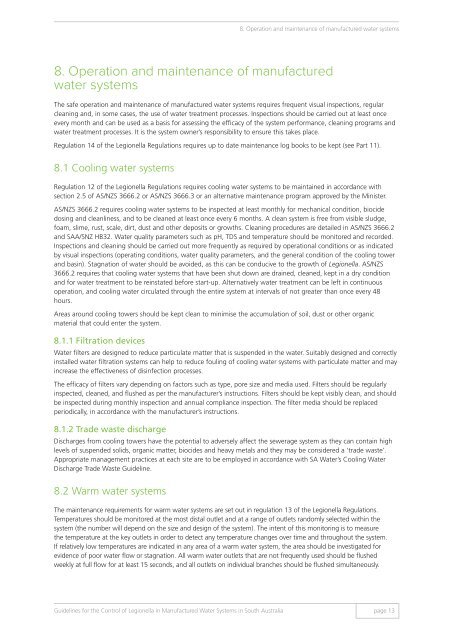Guidelines for the Control of Legionella in Manufactured Water ...
Guidelines for the Control of Legionella in Manufactured Water ...
Guidelines for the Control of Legionella in Manufactured Water ...
Create successful ePaper yourself
Turn your PDF publications into a flip-book with our unique Google optimized e-Paper software.
8. Operation and ma<strong>in</strong>tenance <strong>of</strong> manufactured water systems<br />
8. Operation and ma<strong>in</strong>tenance <strong>of</strong> manufactured<br />
water systems<br />
The safe operation and ma<strong>in</strong>tenance <strong>of</strong> manufactured water systems requires frequent visual <strong>in</strong>spections, regular<br />
clean<strong>in</strong>g and, <strong>in</strong> some cases, <strong>the</strong> use <strong>of</strong> water treatment processes. Inspections should be carried out at least once<br />
every month and can be used as a basis <strong>for</strong> assess<strong>in</strong>g <strong>the</strong> efficacy <strong>of</strong> <strong>the</strong> system per<strong>for</strong>mance, clean<strong>in</strong>g programs and<br />
water treatment processes. It is <strong>the</strong> system owner’s responsibility to ensure this takes place.<br />
Regulation 14 <strong>of</strong> <strong>the</strong> <strong>Legionella</strong> Regulations requires up to date ma<strong>in</strong>tenance log books to be kept (see Part 11).<br />
8.1 Cool<strong>in</strong>g water systems<br />
Regulation 12 <strong>of</strong> <strong>the</strong> <strong>Legionella</strong> Regulations requires cool<strong>in</strong>g water systems to be ma<strong>in</strong>ta<strong>in</strong>ed <strong>in</strong> accordance with<br />
section 2.5 <strong>of</strong> AS/NZS 3666.2 or AS/NZS 3666.3 or an alternative ma<strong>in</strong>tenance program approved by <strong>the</strong> M<strong>in</strong>ister.<br />
AS/NZS 3666.2 requires cool<strong>in</strong>g water systems to be <strong>in</strong>spected at least monthly <strong>for</strong> mechanical condition, biocide<br />
dos<strong>in</strong>g and cleanl<strong>in</strong>ess, and to be cleaned at least once every 6 months. A clean system is free from visible sludge,<br />
foam, slime, rust, scale, dirt, dust and o<strong>the</strong>r deposits or growths. Clean<strong>in</strong>g procedures are detailed <strong>in</strong> AS/NZS 3666.2<br />
and SAA/SNZ HB32. <strong>Water</strong> quality parameters such as pH, TDS and temperature should be monitored and recorded.<br />
Inspections and clean<strong>in</strong>g should be carried out more frequently as required by operational conditions or as <strong>in</strong>dicated<br />
by visual <strong>in</strong>spections (operat<strong>in</strong>g conditions, water quality parameters, and <strong>the</strong> general condition <strong>of</strong> <strong>the</strong> cool<strong>in</strong>g tower<br />
and bas<strong>in</strong>). Stagnation <strong>of</strong> water should be avoided, as this can be conducive to <strong>the</strong> growth <strong>of</strong> <strong>Legionella</strong>. AS/NZS<br />
3666.2 requires that cool<strong>in</strong>g water systems that have been shut down are dra<strong>in</strong>ed, cleaned, kept <strong>in</strong> a dry condition<br />
and <strong>for</strong> water treatment to be re<strong>in</strong>stated be<strong>for</strong>e start-up. Alternatively water treatment can be left <strong>in</strong> cont<strong>in</strong>uous<br />
operation, and cool<strong>in</strong>g water circulated through <strong>the</strong> entire system at <strong>in</strong>tervals <strong>of</strong> not greater than once every 48<br />
hours.<br />
Areas around cool<strong>in</strong>g towers should be kept clean to m<strong>in</strong>imise <strong>the</strong> accumulation <strong>of</strong> soil, dust or o<strong>the</strong>r organic<br />
material that could enter <strong>the</strong> system.<br />
8.1.1 Filtration devices<br />
<strong>Water</strong> filters are designed to reduce particulate matter that is suspended <strong>in</strong> <strong>the</strong> water. Suitably designed and correctly<br />
<strong>in</strong>stalled water filtration systems can help to reduce foul<strong>in</strong>g <strong>of</strong> cool<strong>in</strong>g water systems with particulate matter and may<br />
<strong>in</strong>crease <strong>the</strong> effectiveness <strong>of</strong> dis<strong>in</strong>fection processes.<br />
The efficacy <strong>of</strong> filters vary depend<strong>in</strong>g on factors such as type, pore size and media used. Filters should be regularly<br />
<strong>in</strong>spected, cleaned, and flushed as per <strong>the</strong> manufacturer’s <strong>in</strong>structions. Filters should be kept visibly clean, and should<br />
be <strong>in</strong>spected dur<strong>in</strong>g monthly <strong>in</strong>spection and annual compliance <strong>in</strong>spection. The filter media should be replaced<br />
periodically, <strong>in</strong> accordance with <strong>the</strong> manufacturer’s <strong>in</strong>structions.<br />
8.1.2 Trade waste discharge<br />
Discharges from cool<strong>in</strong>g towers have <strong>the</strong> potential to adversely affect <strong>the</strong> sewerage system as <strong>the</strong>y can conta<strong>in</strong> high<br />
levels <strong>of</strong> suspended solids, organic matter, biocides and heavy metals and <strong>the</strong>y may be considered a ‘trade waste’.<br />
Appropriate management practices at each site are to be employed <strong>in</strong> accordance with SA <strong>Water</strong>’s Cool<strong>in</strong>g <strong>Water</strong><br />
Discharge Trade Waste Guidel<strong>in</strong>e.<br />
8.2 Warm water systems<br />
The ma<strong>in</strong>tenance requirements <strong>for</strong> warm water systems are set out <strong>in</strong> regulation 13 <strong>of</strong> <strong>the</strong> <strong>Legionella</strong> Regulations.<br />
Temperatures should be monitored at <strong>the</strong> most distal outlet and at a range <strong>of</strong> outlets randomly selected with<strong>in</strong> <strong>the</strong><br />
system (<strong>the</strong> number will depend on <strong>the</strong> size and design <strong>of</strong> <strong>the</strong> system). The <strong>in</strong>tent <strong>of</strong> this monitor<strong>in</strong>g is to measure<br />
<strong>the</strong> temperature at <strong>the</strong> key outlets <strong>in</strong> order to detect any temperature changes over time and throughout <strong>the</strong> system.<br />
If relatively low temperatures are <strong>in</strong>dicated <strong>in</strong> any area <strong>of</strong> a warm water system, <strong>the</strong> area should be <strong>in</strong>vestigated <strong>for</strong><br />
evidence <strong>of</strong> poor water flow or stagnation. All warm water outlets that are not frequently used should be flushed<br />
weekly at full flow <strong>for</strong> at least 15 seconds, and all outlets on <strong>in</strong>dividual branches should be flushed simultaneously.<br />
<strong>Guidel<strong>in</strong>es</strong> <strong>for</strong> <strong>the</strong> <strong>Control</strong> <strong>of</strong> <strong>Legionella</strong> <strong>in</strong> <strong>Manufactured</strong> <strong>Water</strong> Systems <strong>in</strong> South Australia page 13

















